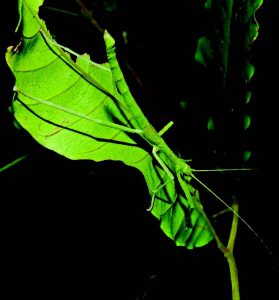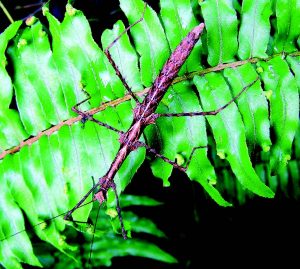The family Phasmatodea is comprised of both the stick and leaf insects, with the former diversifying into a spectacular assemblage of species across the world. Apart from the typical green or brown ones that pose as twigs, there are those that mimic decaying pieces of wood and are therefore found among forest duff. Despite being rather common in suitable habitats, they are as a whole seldom seen due to their cryptic habits and appearances. It is for this reason that the best time to look for them is when the sun has entirely settled down into the horizon.
THE SEARCH BEGINS
In early 2010, I was invited by a small group of European phasmid researchers to explore a remote area in Real, Quezon for these fascinating creatures. We began with a steep hike over a ridge overgrown with grasses and other vegetation that typically appear when the original forests are felled. But even in this unnatural situation, we soon found flying males of some phasmid species as it was already a little past 5 in the afternoon and insect activity is beginning to pick up.
FINDING PHASMIDS
Stenobrimus is a genus that is endemic to the Philippines, currently incorporating three known species, with the last one, S. lumad, having been described in 2010. On this trip, we encountered the rarely seen S. bolivari, which also happens to the type species, or the species where the genus was founded. This is a peculiar thorny-looking animal that feeds chiefly on ferns.

When the darkness finally took over, the diversity and number of stick insects in this area became instantly apparent: at almost every turn, there were phasmids occupying their preferred niches among shrubs, leaf undersides, ferns, and twigs.
The first species I was able to photograph was a female Eubulides igorotte, a twig-like animal with short spines along its dorsum and legs. This one was perched on a leaf and easy to spot, but I suppose that during the daylight hours it would have lingered on or near twigs and branches where it would be extremely difficult for a potential predator to see it.
The first specimen was found in Imugan, Nueva Vizcaya, and the genus name recalls that of a Greek philosopher of the same name who was a contemporary of Aristotle and famed for his logical paradoxes.
Shortly thereafter, a gorgeous specimen of sub-adult female Necroscia thisbe was seen clinging to the underside of a leaf. Its body is orange with a jet-black head and as a whole, it looks as if it were varnished. It was described in 1877, but I was told by one of my companions that it was placed in the wrong genus and that it is better placed in Nescicroa instead.
Another female example was then spotted, this time from a species known as Asceles rulanda rulanda. This one sported a uniformly green body with paler green legs that are edged with minute serrations. The thorax has two pairs of small white tubercles. The genus is widespread in east and southeastern Asia, including China and Japan eastwards to Oceania.
A female nymph of the dead twig mimic Tisamenus serratorius was detected upside down on a leaf underside. This is a robustly built species with a row of low spines along its abdominal region and curiously evokes an ancient samurai warrior in battle regalia.
Tisamenus is a genus endemic to the Philippines, and by day, they are concealed in leaf litter and other debris, ascending to the bushes at night, though they do not go too high.
Interestingly, the name Tisamenus is also a familiar name in mythology and history.
Ophicrania viridinervis is a very attractive species with a bright green body longitudinally striped on the dorsum with black bordered with creamy yellow, and the thorax is striped with blue-green on its sides. The middle and rear legs are coppery red and the head is a creamy yellow with black eyes. The genus name literally translates to ‘snake head’ and is one of the more widely distributed phasmids in the country, with its occurrence reaching up to extreme northern Luzon.
Lonchodiodes dalawangsungay is an interesting phasmid with a green body and brownish-red legs and antennae ornamented with raised whitish bumps.
A related species, L. tagalicus, was observed scrambling over the surrounding greenery. This is a much more gracile animal than L. dalawangsungay and clothed in rich chocolate brown instead of green.
Later on, we found another member of the Eubulides genus, this time E. alutaceus. Like E. igorotte, this species is also predominantly brown, but irregularly mottled with moss green, no doubt serving to aid mimicry.
This is also more sturdily built than the aforementioned relative, with a heavily tuberculated head and thorax that in some places develop into short spines.
On the forest floor, we spotted a species of Mithrenes perched atop a fern frond. Despite being mostly plain brown with sparse, irregular blackish-brown maculations on the legs, this particular individual is rather remarkable for the texture of its dorsum, which approximates those of smooth-barked twigs.
Also of note is that like Tisamenus, the generic name also evokes that of a historical figure, who fought against and with Alexander the Great.
Further above our heads were two nymphs of an Orthomeria species that are only currently referred to as Orthomeria sp. ‘Sierra Madre’. Small nymphs are black with white bands on both ends of the thoracic region, and white, diamond-shaped spots on the abdomen.
They gradually become more iridescent with age, and the eyes turn red, with the thorax and abdominal markings becoming more green. Adults are less colorful, with males being predominantly black with red eyes, and the females an olive-brown; both sexes have with wings with remarkably delicate traceries and orange edges.
Regrettably, no adult of this species was seen for a photograph. Orthomeria species are very fast-moving, almost roach-like, and like roaches, also emit offensive odors when disturbed. Still, species from this genus are highly prized in terraria worldwide.
On bamboo twigs overhead a lovely nymph of O. viridinervis was found. The entire body is baby blue and the legs were a contrasting brownish-red.
We then saw an adult female of Rhamphosiplyloidea philippa on a bamboo twig. This is a mahogany-colored species with alternating blackish bands on its legs. When sufficiently aggravated, they secrete a liquid meant to deter perceived aggressors, including curious humans. Species from this genus can adapt to habitat disturbances and have been noted to follow human habitation.
Shortly after that, we found another example of T. serratorius, which happens to be an adult female. On this specimen, the brown coloration is much more uniform and the spiky projections along its flanks more developed.
The last phasmid species we encountered was Periphetes quezonicus, represented by two specimens, one being a sub-adult female. The nymph was a uniform green with abbreviated black cross bands on the abdominal region, while the sub-adult is more of a metallic olive green with broad black banding on the legs.
This appeared in Animal Scene magazine’s September 2017 issue.






